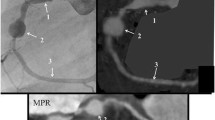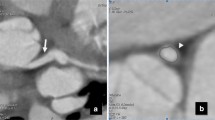Abstract
Background
Transthoracic ECHO is the locally accepted method for coronary surveillance of patients with Kawasaki disease but it may have limited visualization in the older child.
Objective
To assess the feasibility of multidetector CT (MDCT) angiography in the follow-up of coronary artery aneurysms in children with previous Kawasaki disease.
Materials and methods
Six children (5 boys, 1 girl; mean age 11.5 years) with known Kawasaki disease and coronary artery involvement underwent CT coronary angiography using 16-detector MDCT. The visualized lengths and diameter of all coronary segments were measured. The number, size and location of coronary artery aneurysms were recorded and compared with recent ECHO.
Results
Twelve coronary artery aneurysms (seven saccular, five fusiform) were identified by MDCT angiography. One saccular aneurysm at the junction of the distal right coronary artery and posterior descending artery was not detected by ECHO while the remaining six in proximal segments were detected by both modalities. Two of five fusiform aneurysms were not detected by ECHO due to their small sizes. Excellent agreement was found between CT and ECHO for maximal diameter and length of the visualized aneurysms.
Conclusions
MDCT angiography accurately defines coronary artery aneurysms. It is more sensitive for detecting aneurysms at distal coronary segments and fusiform aneurysms of small size.



Similar content being viewed by others
References
Burns JC, Kushner HI, Bastian JF, et al (2000) Kawasaki disease: a brief history. Pediatrics 106:E27
Du ZD, Zhang T, Liang L, et al (2002) Epidemiologic picture of Kawasaki disease in Beijing from 1995 through 1999. Pediatr Infect Dis J 21:103–107
Park YW, Han JW, Park IS, et al (2005) Epidemiologic picture of Kawasaki disease in Korea, 2000–2002. Pediatr Int 47:382–387
Chang RK (2002) Hospitalizations for Kawasaki disease among children in the United States, 1988–1997. Pediatr Infect Dis J 21:1150–1155
Lue HC, Philip S, Chen MR, et al (2004) Surveillance of Kawasaki disease in Taiwan and review of the literature. Acta Paediatr Taiwan 45:8–14
Yanagawa H, Nakamura Y, Ysahiro M, (2001) Incidence survey of Kawasaki disease in 1997 and 1998 in Japan. Pediatrics 107:E33
Hirohisa K, Tetsu S, Teiji A, et al (1996) Heart and vascular Disease in the young: long-term consequences of Kawasaki disease: a 10- to 21-year follow-up study of 594 patients. Circulation 94:1379–1385
Nakamura Y, Yanagawa H, Harada K, et al (2000) Mortality among persons with a history of Kawasaki disease in Japan: existence of cardiac sequelae elevated the mortality. J Epidemiol 10:372–375
Nakamura Y, Aso E, Yashiro M, et al (2005) Mortality among persons with a history of Kawasaki disease in Japan: can paediatricians safely discontinue follow-up of children with a history of the disease but without cardiac sequelae? Acta Paediatr 94:429–434
Newburger JW, Takahashi M, Gerber MA, et al (2004) Diagnosis, treatment and long-term management of Kawasaki disease: a statement for health professionals form the Committee on Rheumatic Fever, Endocarditis, and Kawasaki Disease, Council on Cardiovascular Disease in the Young, American Heart Association. Pediatrics 114:1708–1733
Ministry of Health and Welfare (1984) Report of the Subcommittee on Standardization of Diagnostic Criteria and Reporting of Coronary Artery Lesions in Kawasaki Disease. Research Committee on Kawasaki disease, Ministry of Health and Welfare, Tokyo, Japan
Iemura M, Ishii M, Sugimura T, et al (2000) Long term consequences of regressed coronary aneurysms after Kawasaki disease: vascular wall morphology and function. Heart 83:307–311
Tsuda E, Kamiya T, Ono Y, et al (2005) Dilated coronary arterial lesions in the late period after Kawasaki disease. Heart 91:177–182
Sugimura T, Yokoi H, Sato N, et al (1997) Interventional treatment for children with severe coronary artery stenosis with calcification after long-term Kawasaki disease. Circulation 96:3928–3933
Hiraishi S, Misawa H, Takeda N, et al (2000) Transthoracic ultrasonic visualization of coronary aneurysm, stenosis and occlusion in Kawasaki disease. Heart 83:400–405
Wu MT, Hsieh KS, Lin CC, et al (2004) Images in cardiovascular medicine. Evaluation of coronary artery aneurysms in Kawasaki disease by multislice computed tomographic coronary angiography. Circulation 110:e339
Goo HW, Park IS, Ko JK, et al (2006) Coronary CT angiography and MR angiography in Kawasaki disease. Pediatr Radiol 36:697–705
Sohn S, Kim HS, Lee SW (2004) Multidetector row computed tomography for follow up of patients with coronary artery aneurysms due to Kawasaki disease. Pediatr Cardiol 25:35–39
Kanamaru H, Sato Y, Takayama T, et al (2005) Assessment of coronary artery abnormalities by multislice spiral computed tomography in adolescents and young adults with Kawasaki disease. Am J Cardiol 95:522–525
Greil GF, Stuber M, Botnar RM, et al (2002) Coronary magnetic resonance angiography in adolescents and young adults with Kawasaki disease. Circulation 105:908–911
Lau GT, Ridley LJ, Schieb MC, et al (2005) Coronary artery stenosis: detection with calcium scoring, CT angiography, and both methods combined. Radiology 235:415–422
Schroeder S, Kopp AF, Baumbach A, et al (2001). Noninvasive detection and evaluation of atherosclerotic coronary plaques with multislice computed tomography. J Am Coll Cardiol 37:1430–1435
Becker CR, Knez A, Ohnesorge B, et al (2000) Imaging of noncalcified coronary plaques using helical CT with retrospective ECG gating. AJR 175:423–424
Acknowledgements
We thank Mr. Tom Lee and Mr. James Cheung for their technical support.
Author information
Authors and Affiliations
Corresponding author
Rights and permissions
About this article
Cite this article
Chu, W.C.W., Mok, G.C.F., Lam, W.W.M. et al. Assessment of coronary artery aneurysms in paediatric patients with Kawasaki disease by multidetector row CT angiography: feasibility and comparison with 2D echocardiography. Pediatr Radiol 36, 1148–1153 (2006). https://doi.org/10.1007/s00247-006-0281-4
Received:
Revised:
Accepted:
Published:
Issue Date:
DOI: https://doi.org/10.1007/s00247-006-0281-4




